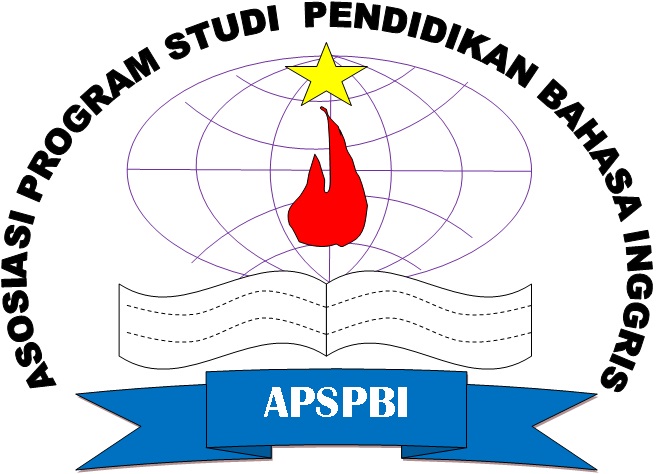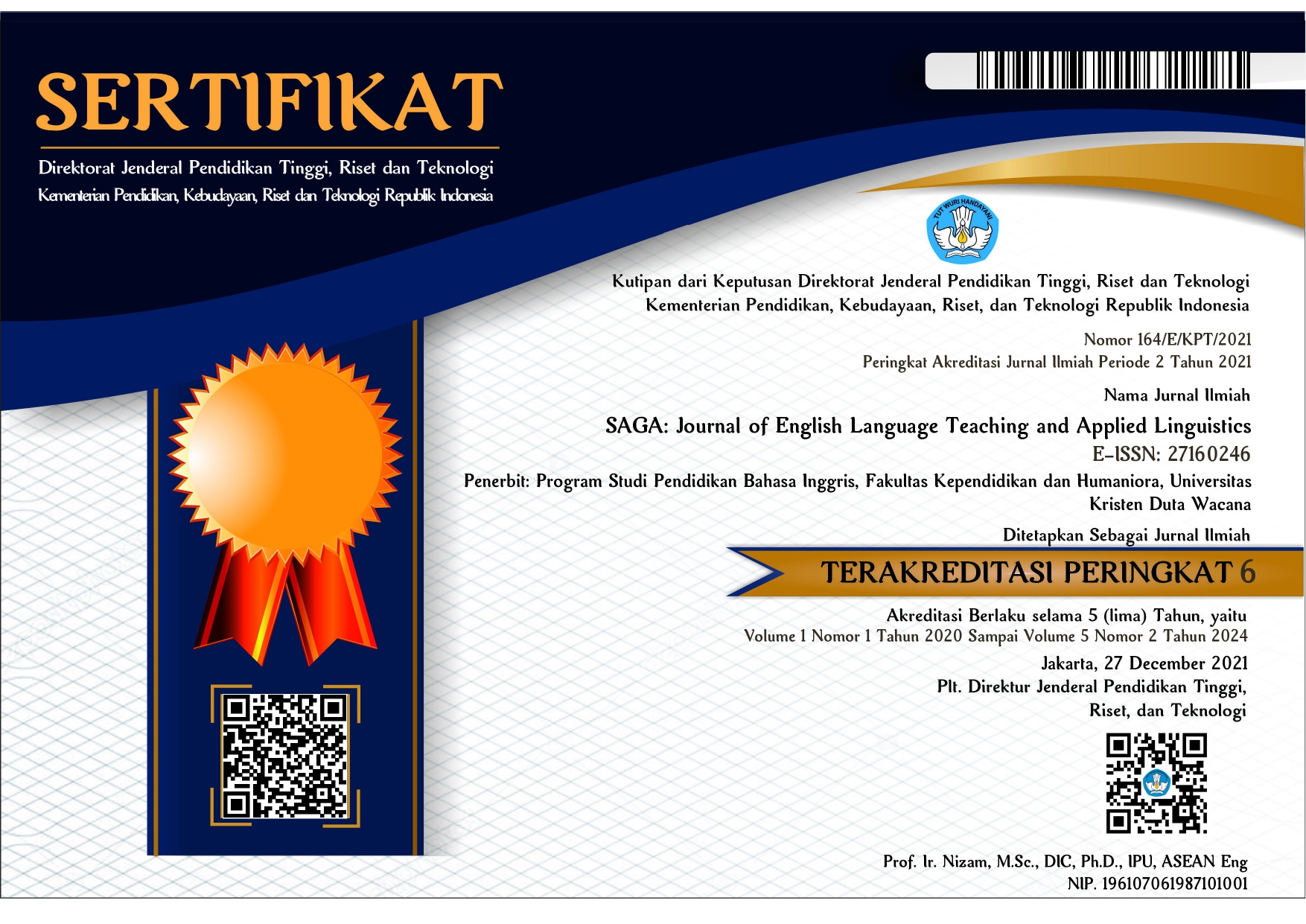The Use of the Cocomelon YouTube Channel as a Medium for Introducing Children's English Vocabulary
DOI:
https://doi.org/10.21460/saga.2022.32.137Keywords:
Children, Vocabulary, YouTube, CocomelonAbstract
YouTube is a video-watching application that is very popular in today's society. Therefore, people can access YouTube anywhere and anytime. Not only ordinary videos, but nowadays, YouTube is also used for academic purposes for children. Children can also learn English by watching stories, music, or YouTube videos. Various videos on YouTube can be helpful. Be accessed easily, one of which is through the Cocomelon Channel. This study aims to explain using the Cocomelon YouTube channel as a learning medium for vocabulary recognition for children aged 6-12 years. This research is a case study with a qualitative method in which the researchers take observation and interview as the data collection technique. The participants in this study were children aged 6 to 12 years. From the children's feedback and interviews with parents, the result shows that using Cocomelon's YouTube channel can affect the addition of new vocabulary for children.
References
Adam, N. F. M., Rusli, N. F. M., Salleh, N. S., Mokhtar, W. K. W., Abdullah, S., & Handrianto, C. (2022). Kensiu language preservation: An analysis based on the typological framework of language threats. Jundishapur Journal of Microbiology, 15(1), 2640-2659.
Albiladi, W. S., Abdeen, F. H., & Lincoln, F. (2018). Learning English through movies: Adult English language learners' perceptions. Theory and Practice in Language Studies, 8(12), 1567-1574. https://doi.org/10.17507/tpls.0812.01
Alhamami, M. (2013). Observation of YouTube language learning videos. Teaching English with Technology, 13(3), 3-17.
Atmowardoyo, H. (2018). Research methods in TEFL studies: Descriptive research, case study, error analysis, and R & D. Journal of Language Teaching and Research, 9(1), 197-204. https://doi.org/10.17507/jltr.0901.25
August, D., & Shanahan, T. (2017). Developing literacy in second-language learners: Report of the National Literacy Panel on Language Minority Children and Youth. Routledge.
Binarkaheni, S. (2019). A language appraisal of hotel web pages in Indonesia five starred hotels: Interpersonal meaning. NOBEL: Journal of Literature and Language Teaching, 10(1), 52-70. https://doi.org/10.15642/NOBEL.2019.10.1.52-70
Bunna, V., Fathimah, S., & Azizah, L. (2020). Media pembelajaran permainan bingo dalam penguasaan kosakata bahasa jerman siswa. In Seminar Nasional LP2M UNM.
Burroughs, B. (2017). YouTube kids: The app economy and mobile parenting. Social Media & Society, 3(2), 1-8. https://doi.org/10.1177/2056305117707189
Busetto, L., Wick, W., & Gumbinger, C. (2020). How to use and assess qualitative research methods. Neurological Research and Practice, 2(1), 1-10. https://doi.org/10.1186/s42466-020-00059-z
Cummins, J. (2005). A proposal for action: Strategies for recognizing heritage language competence as a learning resource within the mainstream classroom. Modern Language Journal, 585-592
Duffy, P. (2008). Using YouTube: Strategies for using new media in teaching and learning. In Enhancing learning through technology: research on emerging technologies and pedagogies (pp. 31-43).
Hakim, L. N. (2019). The implementation of YouTube in teaching vocabulary for young learners. Journal of Advanced English Studies, 2(1), 13-18. http://dx.doi.org/10.47354/jaes.v2i1.50
Handrianto, C., Jusoh, A. J., Goh, P. S. C., Rashid, N. A., & Rahman, M. A. (2020). The role of teachers in drug abuse prevention in schools. International Journal of Academic Research in Business and Social Sciences, 10(11), 708-716. http://dx.doi.org/10.6007/IJARBSS/v10-i11/8131
Handrianto, C., Uçar, A. S., Saputra, E., Nengsih, Y. K., Kenedi, A. K., & Rahman, M. A. (2021). Competences of adult learning facilitators in community service learning: a review of literatures. Kolokium, 9(2), 121-132.
Harrison, H., Birks, M., Franklin, R., & Mills, J. (2017, January). Case study research: Foundations and methodological orientations. In Forum qualitative Sozialforschung/Forum: qualitative social research (Vol. 18, No. 1, pp. 1-17).
Herlina, S., Rahman, M. A., Nufus, Z., Handrianto, C., & Masoh, K. (2021). The development of students’ learning autonomy using tilawati method at a madrasatul quran in south kalimantan. Jurnal Pendidikan Agama Islam, 18(2), 431-450. https://doi.org/10.14421/jpai.2021.182-12
Hidayati, I. N. (2020). Meaningful and memorable learning: Integrating TPR and YouTube videos to teach vocabulary. International Journal of Quantitative Research and Modeling, 1(2), 100-111.
Ibrahim, R., Hock, K., Handrianto, C., Rahman, M., & Dagdag, J. (2021). Perceptions of parents and teachers on students with learning disabilities (SLD) in Malaysia. International Journal of Education, Information Technology, and Others, 4(2), 287-298. https://doi.org/10.5281/zenodo.5057585
Imaniah, I., Dewi, N. F. K., & Zakky, A. (2020). YouTube kids channels in developing young children’s communication skills in English: Parents’ beliefs, attitudes, and behaviors. Ijlecr - International Journal of Language Education and Culture Review, 6(1), 20-30.
Izci, B., Jones, I., Özdemir, T. B., Alktebi, L., & Bakir, E. (2019). Youtube and young children: Research, concerns and new directions. Crianças, famílias e tecnologias. Que desafios? Que caminhos? 81-92.
Krishnan, I. A., Ching, H. S., Ramalingam, S., Maruthai, E., Kandasamy, P., De Mello, G., ... & Ling, W. W. (2020). Challenges of learning English in 21st century: Online vs. Traditional during covid-19. Malaysian Journal of Social Sciences and Humanities (MJSSH), 5(9), 1-15.
Lin, M. F. G., Michko, G., & Bonk, C. J. (2009). Characteristics of YouTube use and users: implications for education. In E-Learn: World Conference on E-Learning in Corporate, Government, Healthcare, and Higher Education (pp. 2855-2862). Association for the Advancement of Computing in Education (AACE).
McCarthy, M., & Carter, R. (2014). Language as discourse: Perspectives for language teaching. Routledge.
Mullick, A., Ghosh D, S., Maheswari, S., Sahoo, S., Maity, S. K., & Goyal, P. (2018, January). Identifying opinion and fact subcategories from the social web. In Proceedings of the 2018 ACM Conference on Supporting Groupwork (pp. 145-149).
Nengsih, Y. K., Handrianto, C., Pernantah, P. S., Kenedi, A. K., & Tannoubi, A. (2022). The implementation of interactive learning strategy to formulating learning objectives in package c program. Spektrum: Jurnal Pendidikan Luar Sekolah (PLS), 10(2), 311-317. https://doi.org/10.24036/spektrumpls.v10i2.117215
Neumann, M. M., & Herodotou, C. (2020). Evaluating YouTube videos for young children. Education and Information Technologies, 25(5), 4459-4475.
Nunan, D. (1999). A foot in the world of ideas: Graduate study through the Internet. Language Learning & Technology, 3(1), 52-74.
Pinter, A. (2017). Teaching young language learners. Oxford University Press.
Rahman, M. A., & Ja’afar, H. (2018). A review of the mingle model as a new technique in teaching speaking: Indonesian context. LET: Linguistics, Literature and English Teaching Journal, 7(2), 181-194. http://dx.doi.org/10.18592/let.v7i2.1949
Rahman, M. A., Jamalullail, J., & Handrianto, C. (2021). An overview of the implementation of musical drama in the introduction to literature course. IJEA, 4(2), 9-19. https://doi.org/10.26499/ijea.v4i2.156
Rahman, M. A., Novitasari, D., Handrianto, C., & Rasool, S. (2022). Assessment challenges in online learning during the covid-19 pandemic. KOLOKIUM Jurnal Pendidikan Luar Sekolah, 10(1). https://doi.org/10.24036/kolokium.v10i1.517
Safitri, H., & Hakim, M. N. (2018). First language acquisition of a three year old child: An analysis of phonological component (a case study). IJLECR-International Journal of Language Education and Culture Review, 4(2), 150-154.
Saville-Troike, M., & Barto, K. (2017). Introducing second language acquisition. Cambridge University Press.
Sihotang, L., Setiawan, D., & Saragi, D. (2017). The effect of learning strategy and self-confidence toward student’s learning outcomes in elementary school. IOSR Journal of Research & Method in Education (IOSR-JRME), 7(4), 65-72.
Subekti, A. S. (2020). Alleviating anxiety, boosting confidence: A proposed model of Willis’ task-based learning. Journal of English Language Teaching and Linguistics, 5(1), 131-144.
Subekti, A. S. (2021). Indonesian learners’ self-directed learning and resilience in online English classes: Assessing interaction with L2 achievement. IJEE (Indonesian Journal of English Education), 8(1).
Subekti, A. S. (2019). Situational willingness to communicate in English: Voices from Indonesian non-English major university students. IJELTAL (Indonesian Journal of English Language Teaching and Applied Linguistics), 3(2), 373-390.
Tiara, A., Rahman, M., & Handrianto, C. (2021). The Students’ Perception about Use of Duolingo Application for Improving English Vocabulary. International Journal of Education, Information Technology, and Others, 4(4), 690-701. https://doi.org/10.5281/zenodo.5775915
Veblen, K. K., Kruse, N. B., Messenger, S. J., & Letain, M. (2018). Children’s clapping games on the virtual playground. International Journal of Music Education, 36(4), 547-559.
Yelland, N. (2016). Teaching and learning with tablets: A case study of twenty-first-century skills and new learning. In Apps, Technology and Younger Learners (pp. 77-92). Routledge.
















